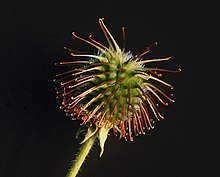Bur




A bur (also spelled burr)[1] is a seed or dry fruit or infructescence that has hooks or teeth.
Some other forms of diaspores, such as the stems of certain species of cactus also are covered with thorns and may function as burs.
Bur-bearing plants such as Xanthium species are often single-stemmed when growing in dense groups, but branch and spread when growing singly.[2]
Function
Burs catch on the fur of passing animals or the clothing of people. The hooks or teeth generally cause irritation, and some species commonly cause gross injury to animals, or expensive damage to clothing or to vehicle tires.
Burs serve the plants that bear them in two main ways.
- Firstly, burs tend to repel some herbivores, much as other spines and prickles do.
- Secondly, plants with burs rely largely on living agents to disperse their seeds; their burs are mechanisms of seed dispersal by epizoochory (dispersal by attaching to the outside of animals).[3]
Most epizoochorous burs attach to hair on the body or legs of the host animal, but a special class of epizoochorous bur is known as the trample-bur (or trample-burr). Several species of Tribulus, Harpagophytum, and Grielum produce fruit in the form of trample-burs. As the name suggests, they attach themselves to the animal when trampled. They may hook onto the legs of animals as the large hooks of Harpagophytum do, sometimes causing serious injury, but sometimes hooking onto the leg of say, an ostrich, apparently without causing discomfort.[4] It also might penetrate a hoof or foot pad or the tires of a vehicle, only to be shed after being carried for a considerable time and distance; most Tribulus and Grielum species are specialised for such attachment, variously being flat, but with upward-directed spikes as in say, Grielum humifusum,[5] or shaped like a caltrop as in some species of Tribulus that have achieved the status of cosmopolitan weeds by sticking to the tires of aircraft.[6]
Relevance to humans
Burs are best known as sources of irritation, injury to livestock, damage to clothing, punctures to tires, and clogging equipment such as agricultural harvesting machinery.
Some have however been used for such purposes as fabric fulling, for which the fuller's teasel is a traditional resource.
The bur of burdock was the inspiration for hook and loop fastener, also known as Velcro.[7]
Common plants with burs
Common bur-bearing plants include:
- Acanthospermum australe
- Anthriscus caucalis (burr chervil)
- Arctium lappa (greater burdock)
- Bidens pilosa (beggar ticks)[3]
- Cenchrus longispinus (longspine sandbur)[8]
- Daucus carota (Queen Anne's lace)
- Galium aparine (cleavers)[9]
- Geum aleppicum (yellow avens)[10]
- Geum canadense (white avens)[11]
- Geum urbanum (herb bennet)
- Tribulus terrestris (puncturevine)[12]
- Xanthium strumarium (cocklebur)[13]
References
- ^ Cook, J. Gordon (1968). ABC of Plant Terms. Watford, Herts: Merrow. OCLC 223208923.
- ^ Noogoora burr, Californian burr, Italian cockleburr and South American burr (Xanthium species). New South Wales Department of Primary Industries. 2009.
- ^ a b Magee, M. B. Plants With Burrs. San Francisco Chronicle.
- ^ Midgley, J.J. and Illing, N. Were Malagasy Uncarina fruits dispersed by the extinct elephant bird? South African Journal of Science 105, November/December 2009
- ^ Karen van Rheede van Oudtshoorn; Margaretha W. van Rooyen (1999). Dispersal Biology of Desert Plants. Springer. pp. 95–. ISBN 978-3-540-64886-4.
- ^ Holm, L. et al. A geographical atlas of world weeds. Krieger 1991, ISBN 978-0894643576
- ^ Suddath, Claire (15 June 2010). "A Brief History of: Velcro". Time. Retrieved 17 October 2018 – via content.time.com.
- ^ Cenchrus longispinus. University of California IPM.
- ^ Gorb, E.; Gorb, S. (2002). "Contact separation force of the fruit burrs in four plant species adapted to dispersal by mechanical interlocking". Plant Physiology and Biochemistry. 40 (4): 373–381. doi:10.1016/S0981-9428(02)01381-5.
- ^ [1] Ontario Wildflowers
- ^ [2] Ontario Wildflowers
- ^ Tribulus terrestris. University of California IPM.
- ^ Xanthium strumarium. University of California IPM.
External links
- Chisholm, Hugh, ed. (1911). . Encyclopædia Britannica (11th ed.). Cambridge University Press.
